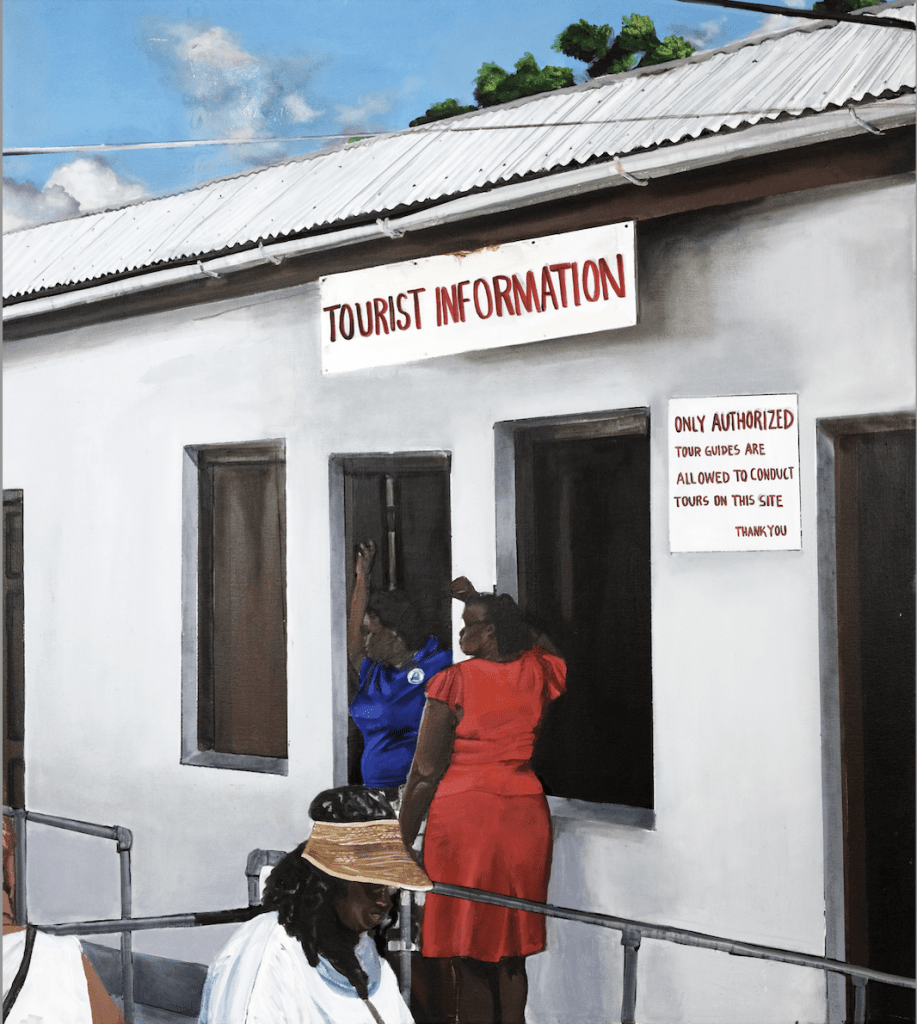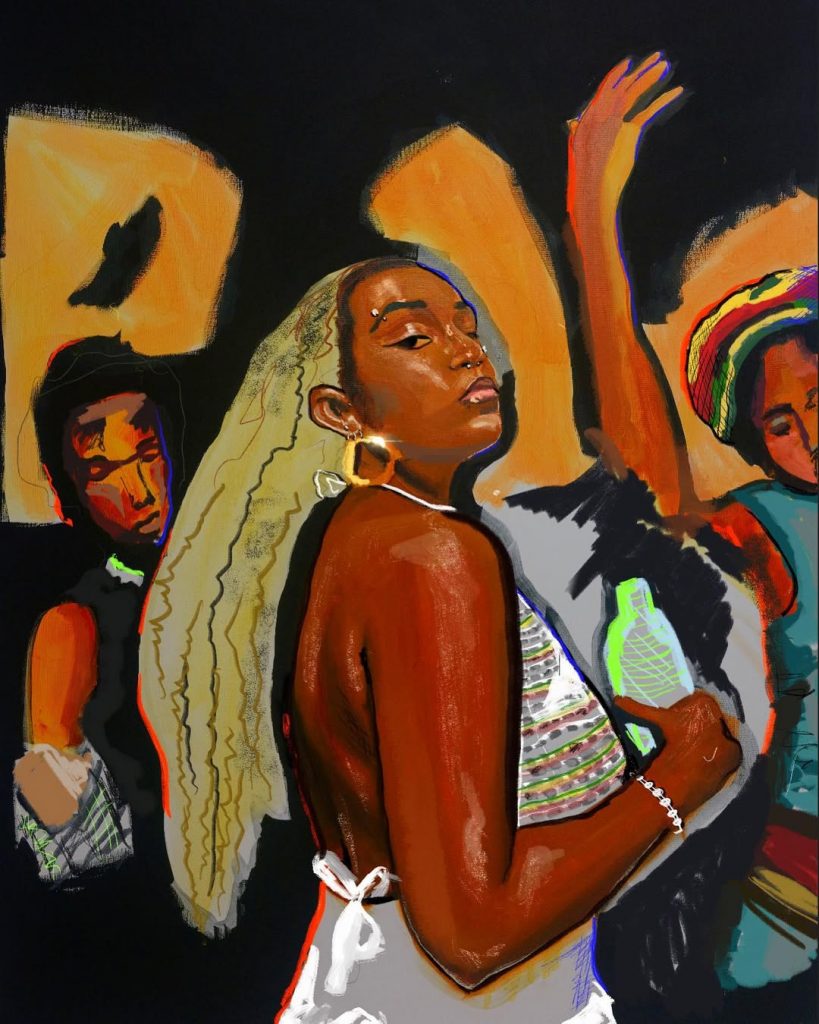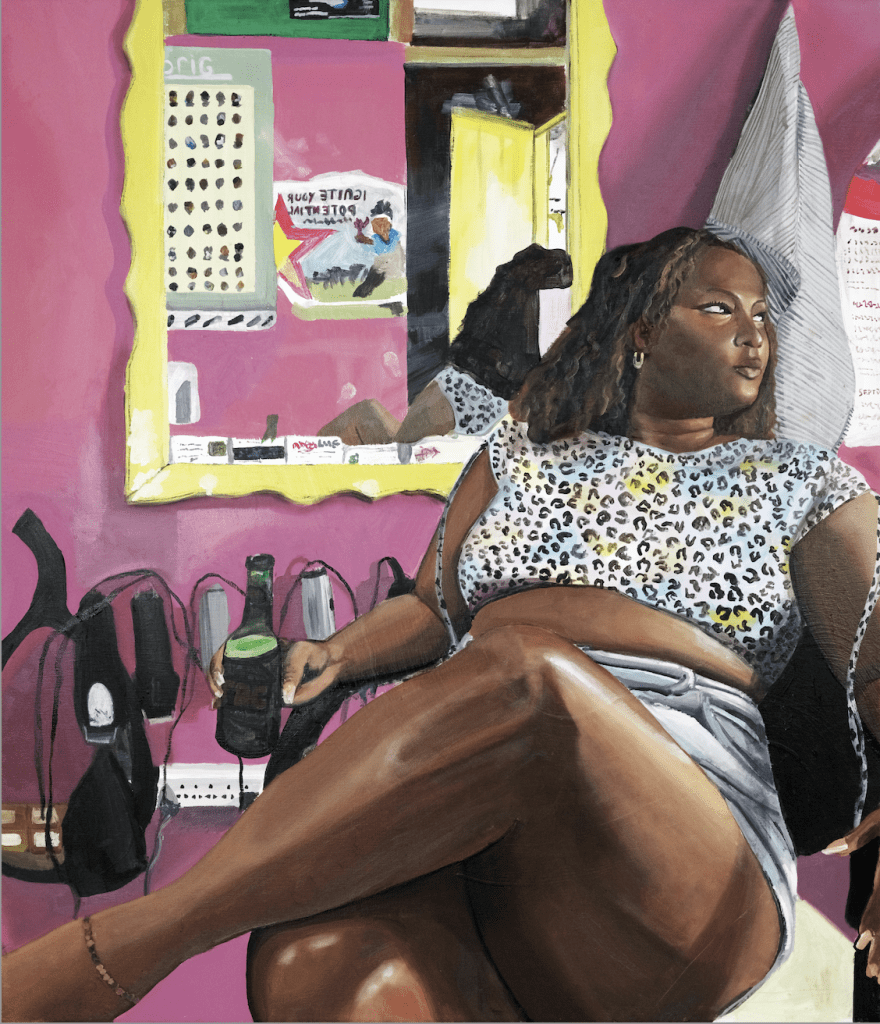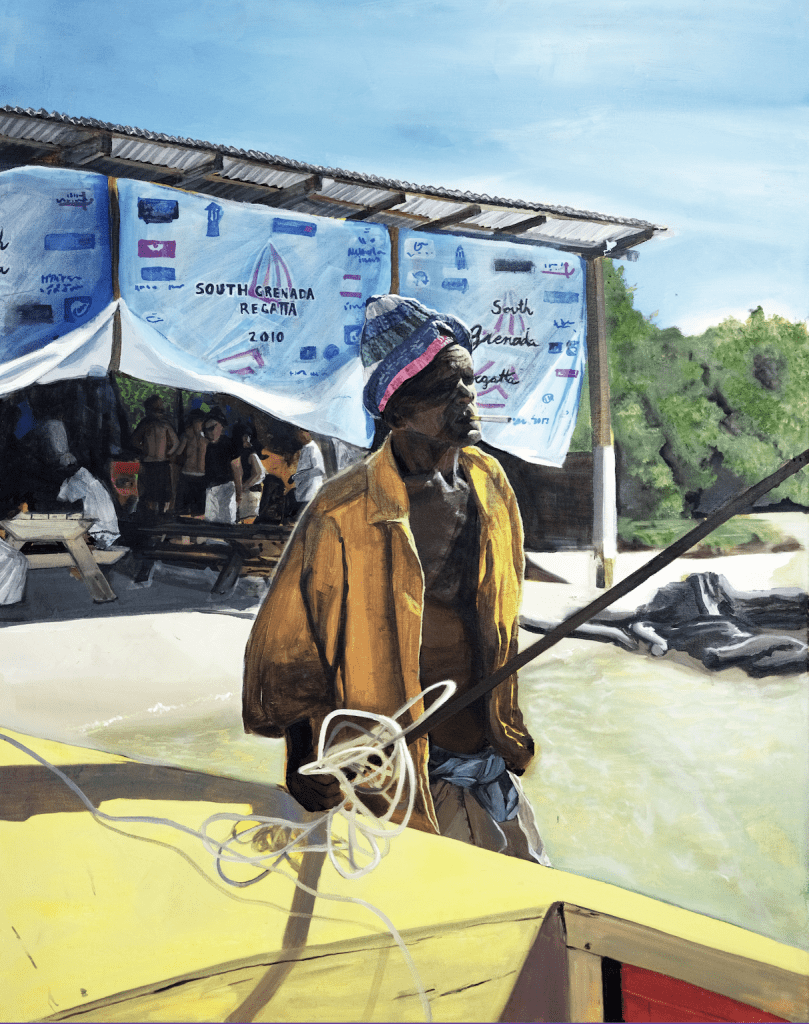AiR: Chawntay Barrett Paints Her Relationship To Home
By Nia Centre, p
Posted on January 31, 2025

Certain familiar scenes come to mind when we think about the Caribbean. Postcard stretches of plush, dimpled beaches, with blue waves breaking against the white coastline. Lush, rolling green hills interrupted by fuschia explosions of bougainvillea, and the palm trees curving towards the sun. Squat houses painted in vibrant reds, or yellows, or greens. Those of us with a visual relationship to the Caribbean can easily conjure those images. But the scene that Chawntay Barrett chose to render of Grenada, where half her family originates — the other half is from Jamaica — focuses instead on a less likely subject, particularly for someone with ancestral claim to the land: an information centre for tourists.
The painting depicts two Grenadian women, one dressed in bright red and the other in dark blue, leaning protectively against the windowsills of an old gray building, staring into the distance beneath a rusting “TOURIST INFORMATION” sign and the slice of azure sky hanging above it. Barrett worked on Tourist Information while she was the 2024 Artist in Residence at Nia Centre, and it became the first original canvas she’d ever sold when it was purchased at A Black Art Fair in late November. The scene was drawn from a photograph she took while living with her mother, grandmother and sister in Grenada back in 2020, an adventure she says fundamentally shifted the way she thought of herself in relation to the diaspora. “I would make friends with people there, and they’d be like, ‘You’re foreign — where are you from?’” says Barrett. “And I would get a little bit defensive, because I’d be like, ‘What do you mean? I’m from here.’”

It wasn’t that she misunderstood the origins of the question. In fact, those two months were the longest amount of time she had ever spent in Grenada, and while she still refers to the island with the prickly language of back home, the experience underscored just how Canadian she had really become. Barrett found herself in the surreal position of taking expeditions with tourists to learn more about the history and geography of an island that simultaneously belongs and does not belong to her. “I just wanted to highlight the weirdness of that perspective, being a tourist in your own home country,” she says. She had never felt the limbo of diaspora so acutely.
Lately, an interrogation of home, Caribbean culture, and Black womanhood has been finding its way into her paintings. It’s a way for the artist to make sense of her identity, her social and geographical position in the world. Barrett often works from photographs or videos that she’s captured herself, but she likes to augment the colours beyond the photorealistic; some of her favourite painters include the African-American portraitists Barkley L. Hendricks and Jordan Casteel, who are both known for their vibrancy and attention to style. A nostalgic feeling can arise from looking at her paintings, and the sense that you have entered the hazy, longing memories of another person.

Queen of the Dancehall is, for example, a somewhat abstracted scene from a humid jam, where three brown-skinned women lose themselves in the riddims of a song the viewer cannot hear. Tee in Sheddy’s Shop, which was exhibited alongside Tourist Information at A Black Art Fair, depicts Barrett’s older sister reclining in a family friend’s pink-walled barbershop in Grenville. “Something I noticed while living in Grenada is that the men will build wooden bars on the side of the road, install fridges and pack them with beers, and then people would go there after work, and you’d have these small communities just chilling at these intersections,” says Barrett. “Canada doesn’t necessarily have those improvised community hubs like that, you know? Even the barbershops [in Grenada] are like third spaces, too — people would just be there hanging out, even if they weren’t getting their haircuts.”

Though she’s now been a practicing artist for about four years, Barrett did not have a straight shot into the art world. In fact, when she was an undergraduate student at the University of Guelph, she was studying biology, with the intent of becoming a scientist. “Of course I had to finish my science degree, because I have Caribbean parents,” she jokes. But she always knew that she was more satiated by art than by her love for analyzing cells under microscopes. Even in high school, when she maxed out her course-load with physics and chemistry, she always made a point to slot in an elective related to art.
In university, she enrolled in an arts-based experiential learning semester abroad in London, and it was during her studies there that she began to get a sense of the possibilities of being a visual artist. One course took place only in galleries and museums; another was focused solely on performance art. She was also exposed to a creative culture that felt much more free than she was used to, including family members her own age who also considered themselves artists, which made it seem more plausible. “When I got back, I immediately added Studio Art as my minor, and decided I would stay an extra year at school to get it done so I could pursue art when I graduated,” says Barrett. “I used a loan to get an iPad, and started getting into digital art. That was my start. I did some community programs and submitted artwork to a couple of open calls, and we’ve been zooming ever since.”

After graduating in 2020, Barrett was announced as one of the recipients of the Toronto Arts Council NEXT stream. The following year, she graduated from a program for emerging Black artists through VIBE Arts, which culminated in her first-ever exhibition, an installation that explored the origins and identity of the Black Barbie doll. In 2024, she was selected as Nia Centre’s Artist-in-Residence for the year — the first time she had ever been granted a residency. “It was really amazing to have a space to create work that wasn’t in isolation,” says Barrett. “Painting can be really lonely as a medium. But being in this big glass room where everyone can see you, and people want to walk into the space and chat about your work — that was really incredible and new for me, and the space really felt like home.” Returning to the Centre for A Black Art Fair felt like a homecoming. “I’m forever thankful for the sense of community and support that Nia Centre for the Arts creates,” says Barrett.
Interested in Barrett’s practice? Follow the artist on Instagram and keep up with her work.
About the Artist in Residence Program
Nia Centre’s AiR program provides a small annual cohort of Black artists with the resources, tools and support necessary to jumpstart their careers.
You can learn more about the program here.
Copyright © 2025 Nia Centre for the Arts All Right Reserved.